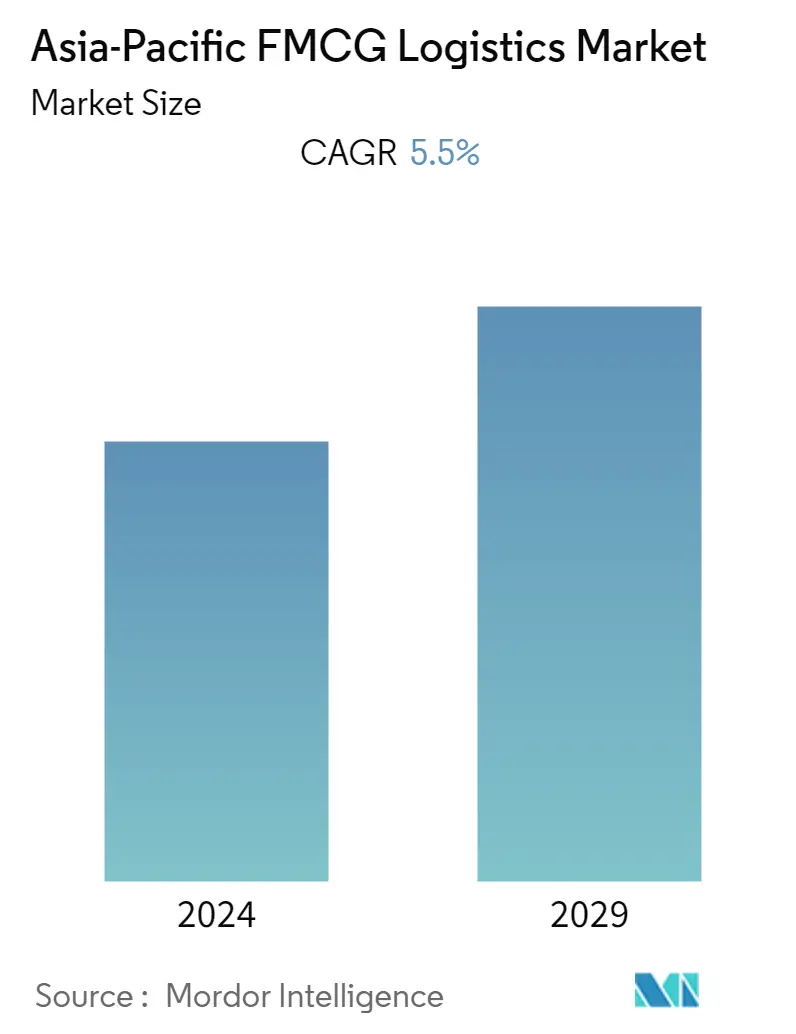Market Size of Asia-Pacific FMCG Logistics Industry

| Study Period | 2020 - 2029 |
| Base Year For Estimation | 2023 |
| Forecast Data Period | 2024 - 2029 |
| Historical Data Period | 2020 - 2022 |
| CAGR | 5.50 % |
| Market Concentration | Low |
Major Players
*Disclaimer: Major Players sorted in no particular order |
Asia Pacific FMCG Logistics Market Analysis
The Asia-Pacific FMCG Logistics Market is expected to grow at a CAGR of around 5.5% during the forecasted period. Fast-moving consumer goods (FMCG) include food and beverages, personal care, home care, and other consumer goods. FMCG logistics comprises the storage, warehousing, and value-added services provided to FMCG companies by logistics vendors. Changing lifestyles, rapidly evolving consumer habits, and ease of access are the key growth drivers for the consumer goods industry. Consumers expect a large variety of items to be available at local and online retailers at all times. To accomplish this demand, the FMCG companies require highly efficient, flexible, and sustainable global supply chains services from logistics service providers.
Asia Pacific FMCG Logistics Industry Segmentation
Asia-Pacific FMCG Logistics Market report provides insights on the market like Market Overview, Market Dynamics, Value Chain / Supply Chain Analysis, Technological Trends, Investment Scenarios, Government Regulations and Initiatives, Insights on 3PL market in Asia-Pacific (Market Size and Forecast), Impact of Covid-19 on FMCG Logistics Market and Industry Attractiveness - Porter's Five Forces Analysis.
| By Service | |
| Transportation | |
| Warehousing, Distribution, and Inventory Management | |
| Other Value-added Services |
| By Product Category | |
| Food and Beverage | |
| Personal Care | |
| Household Care | |
| Other Consumables |
| By Geography | |
| China | |
| India | |
| Japan | |
| South Korea | |
| Singapore | |
| Indonesia | |
| Vietnam | |
| Malaysia | |
| Thailand | |
| Australia | |
| Rest of Asia-Pacific |
Asia-Pacific FMCG Logistics Market Size Summary
The Asia-Pacific FMCG logistics market is poised for significant growth, driven by evolving consumer habits and the increasing demand for efficient supply chain solutions. As consumers expect a wide variety of products to be readily available both in physical stores and online, FMCG companies are relying on logistics vendors to provide flexible, sustainable, and efficient services. This demand is further amplified by the rise in FMCG and pharmaceutical sales, which has led to a surge in the need for cold storage warehouses. These facilities are crucial for maintaining the quality of temperature-sensitive products, such as fresh produce and pharmaceuticals, throughout the supply chain. The region's rapid urbanization and changing consumer preferences, particularly in countries like India, China, and Japan, are contributing to the robust demand projections for FMCG logistics services.
The competitive landscape of the Asia-Pacific FMCG logistics market is highly fragmented, with numerous players vying for market share. Major logistics providers, including DHL Group, C.H. Robinson Worldwide Inc., and Kuehne + Nagel International AG, are actively expanding their operations to meet the growing demand for efficient logistics solutions. The market's growth is further supported by the increasing sales of FMCG products, which are essential in nature and expected to continue rising in the coming years. The ongoing expansion of the cold chain logistics sector, driven by the need for refrigerated warehousing and transportation, is also a key factor in the market's development. As the region is set to become a leading consumer of food and beverages, the opportunities for FMCG logistics service providers are expected to expand, offering significant potential for growth and investment.
Asia-Pacific FMCG Logistics Market Size - Table of Contents
-
1. MARKET INSIGHTS
-
1.1 Current Market Scenario
-
1.2 Value Chain / Supply Chain Analysis
-
1.3 Technological Trends
-
1.4 Investment Scenarios
-
1.5 Government Regulations and Initiatives
-
1.6 Insights on 3PL market in Asia-Pacific (Market Size and Forecast)
-
1.7 Impact of Covid-19 on FMCG Logistics Market
-
-
2. MARKET SEGMENTATION
-
2.1 By Service
-
2.1.1 Transportation
-
2.1.2 Warehousing, Distribution, and Inventory Management
-
2.1.3 Other Value-added Services
-
-
2.2 By Product Category
-
2.2.1 Food and Beverage
-
2.2.2 Personal Care
-
2.2.3 Household Care
-
2.2.4 Other Consumables
-
-
2.3 By Geography
-
2.3.1 China
-
2.3.2 India
-
2.3.3 Japan
-
2.3.4 South Korea
-
2.3.5 Singapore
-
2.3.6 Indonesia
-
2.3.7 Vietnam
-
2.3.8 Malaysia
-
2.3.9 Thailand
-
2.3.10 Australia
-
2.3.11 Rest of Asia-Pacific
-
-
Asia-Pacific FMCG Logistics Market Size FAQs
What is the current Asia-Pacific FMCG Logistics Market size?
The Asia-Pacific FMCG Logistics Market is projected to register a CAGR of 5.5% during the forecast period (2024-2029)
Who are the key players in Asia-Pacific FMCG Logistics Market?
DHL, C. H. Robinson, Kuehne + Nagel International AG, Agility Logistics and CEVA Logistics are the major companies operating in the Asia-Pacific FMCG Logistics Market.

